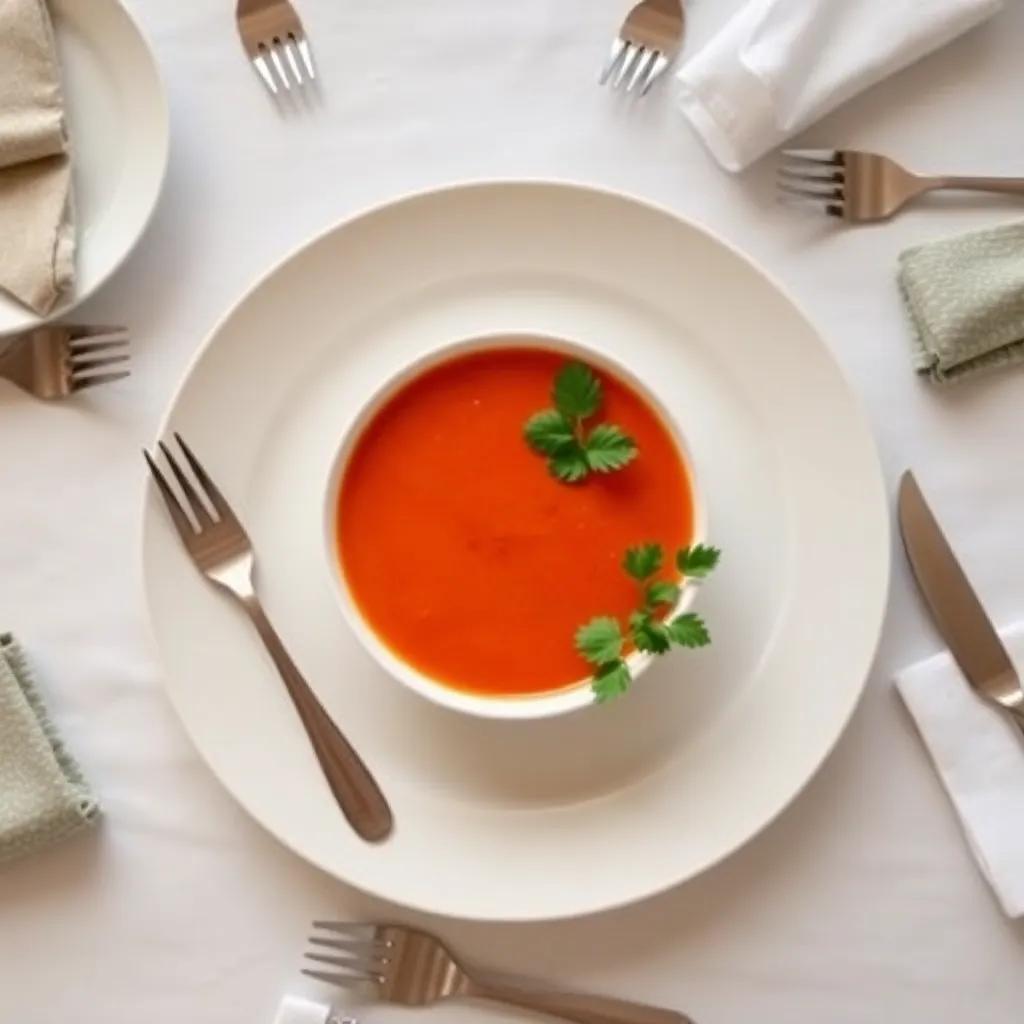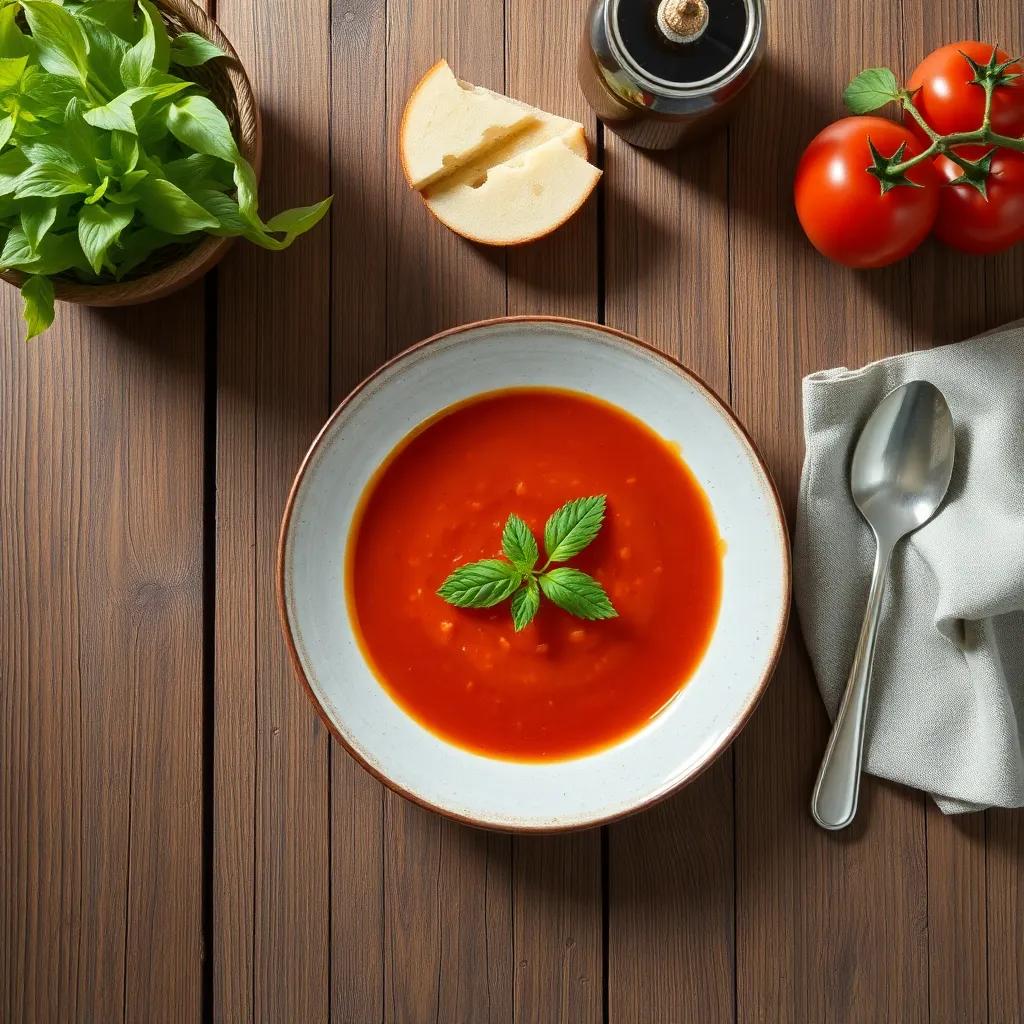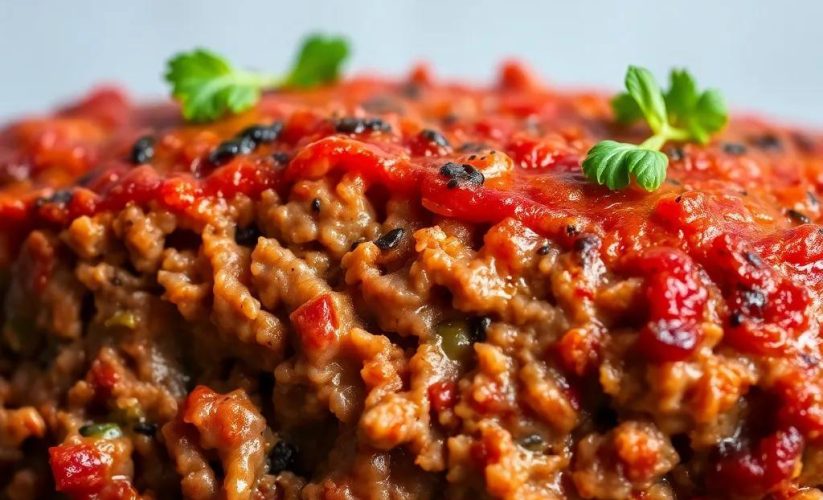Chilled Gazpacho Mastery: Easy, Vegan & Gluten-Free Recipe

Chilled Gazpacho Mastery: Easy, Vegan & Gluten-Free Recipe
🌍 Cuisine: Spanish
⚙️ Difficulty: Easy
Ingredients
Nutrition Facts
120
Instructions
- Wash all fresh produce thoroughly under cold running water.
- In a large blender or food processor, combine the chopped tomatoes, cucumber, red bell pepper, and red onion.
- Add the minced garlic cloves to the blender.
- Pour in the extra virgin olive oil and red wine vinegar.
- Add a pinch of salt and freshly ground black pepper to taste.
- Blend all ingredients until smooth but still slightly textured, about 30-45 seconds.
- Slowly add the cold water while blending to reach your preferred gazpacho consistency.
- Taste and adjust seasoning if necessary, adding more salt, pepper, or vinegar as desired.
- Refrigerate the gazpacho for at least 2 hours, preferably overnight, to allow flavors to meld and the soup to chill thoroughly.
- Before serving, stir the gazpacho well. If it’s too thick, add a little more cold water to loosen it.
- Ladle the chilled gazpacho into bowls or glasses.
- Garnish with fresh basil or parsley and sprinkle a pinch of smoked paprika if using.
- Serve immediately, accompanied optionally by gluten-free bread or crudités.
Serving Suggestions
- Serve chilled in small bowls as a refreshing summer appetizer.
- Pair with gluten-free crusty bread or crackers for dipping.
- Top with diced avocado or cucumber for extra texture.
- Garnish with fresh herbs like basil, cilantro, or parsley for added flavor.
- Add a drizzle of high-quality olive oil for richness.
- Serve alongside a fresh salad or grilled vegetables for a light meal.
- For an extra kick, add a few drops of hot sauce or a pinch of cayenne pepper.
Table of Contents

Intro
There’s something truly refreshing about a bowl of chilled gazpacho on a warm day—a vibrant, invigorating blend that awakens your palate without any fuss. This easy, vegan, and gluten-free recipe captures the true spirit of Spanish cuisine, offering a no-cook, wholesome appetizer that’s as nourishing as it is delicious. Perfect for lazy summer afternoons, casual get-togethers, or whenever you crave something light yet satisfying, gazpacho delivers bold, bright flavors with little time or effort.
What makes this recipe particularly exciting is how effortlessly it transforms simple, fresh ingredients into a harmonious dish that feels both rustic and refined. Whether you’re looking for a quick starter to impress guests or a cooling snack after a day in the sun, mastering this chilled soup is a great way to elevate your culinary repertoire. Plus, its naturally plant-based nature means it aligns beautifully with various dietary preferences, making it universally approachable without compromising on taste or texture.
Embrace the joy of assembling a colorful, nutrient-packed bowl that celebrates nature’s bounty and the art of simplicity—and enjoy a little taste of Spain wherever you are.
Ingredient Notes
When it comes to crafting the perfect chilled gazpacho, a handful of ingredients truly define the character and quality of the finished dish. Let’s delve into a few essentials that elevate this vibrant Spanish classic beyond just a simple blend of vegetables.
Ripe Tomatoes:
The foundation of any authentic gazpacho, tomatoes bring juiciness, natural sweetness, and acidity that balance the soup. For the best flavor, seek out tomatoes that are deeply colored, fragrant, and slightly soft to the touch—think vine-ripened or heirloom varieties if available. These fresh tomatoes contribute not only a lush taste but also vibrant color and antioxidants like lycopene. If fresh tomatoes are out of season, high-quality canned whole peeled tomatoes (preferably San Marzano) can work in a pinch, though they’ll produce a slightly different texture and brightness.
Extra Virgin Olive Oil:
A drizzle of quality extra virgin olive oil adds richness, smoothness, and a subtle peppery note that rounds out gazpacho’s brightness. Rather than just a cooking fat, it acts as a flavor enhancer, helping to marry the acidic vinegar and fresh vegetables into a harmonious blend. Look for robust, fruity varieties labeled “extra virgin” and shop from trusted brands or local producers when possible. If you need a substitute, cold-pressed avocado oil can offer a mild buttery texture, but the distinctive olive oil aroma is truly unique.
Red Wine Vinegar:
This ingredient introduces a crisp, tangy acidity that brightens the entire soup and gives gazpacho its classic zing. Red wine vinegar’s slightly sharp yet mellow flavor complements the raw vegetables perfectly. When selecting vinegar, opt for unfiltered and organic bottles for maximum depth and authenticity. For a twist, you might experiment with sherry vinegar or apple cider vinegar; each will alter the flavor profile subtly but deliciously.
Smoked Paprika (Optional):
Although not mandatory, a pinch of smoked paprika adds a warm, earthy undertone that enhances the soup’s complexity and nods to traditional Spanish seasonings. This ingredient can introduce a slightly smoky depth without overpowering the fresh vegetable flavors. When purchasing, quality matters—choose a Spanish brand if you can for authentic taste, and store it away from light to preserve its smoky aroma. If you prefer to omit it, consider a hint of ground cumin or sweet paprika to gently shift the flavor.
By paying attention to these key ingredients and sourcing them thoughtfully, your gazpacho will not only taste fresh and vibrant but also carry the subtle nuances that make this simple dish truly memorable. These choices help transform just-a-salad-in-a-blender into a refreshing masterpiece perfect for any occasion.
Tips & Variations
To truly master your chilled gazpacho, here are some savvy tips and creative variations that can help you tailor this classic to suit your tastes and dietary needs:
- Balance Is Key: When blending, aim for a texture that is smooth yet slightly chunky—it keeps the soup interesting. If it feels too thick, add ice-cold water gradually to reach your preferred consistency without diluting the flavor. A splash of extra vinegar or a pinch of salt after chilling often brightens the final taste, so don’t hesitate to adjust seasoning just before serving.
- Chill Time Matters: While a couple of hours in the fridge is the minimum, letting gazpacho rest overnight really allows the flavors to marry beautifully. This gives the sharp notes time to mellow and the natural sweetness of the vegetables to emerge more fully.
- Customize Your Crunch: For a classic touch, reserve a small portion of diced cucumber, red pepper, or tomato to sprinkle on top as garnish. This adds a satisfying contrast to the smooth soup and makes for an appealing presentation. Toasted seeds or finely chopped olives can also add an exciting crunch and burst of flavor.
- Boost the Umami: If you want depth without compromising vegan or gluten-free status, try adding a splash of tamari or a teaspoon of nutritional yeast during blending. These ingredients contribute savory notes and complexity that make the gazpacho feel more substantial.
- Play With Herbs and Spices: While basil and parsley are traditional garnishes, feel free to experiment with fresh cilantro, mint, or even a few leaves of arugula blended in for a peppery edge. A pinch of cumin, coriander, or a subtle hint of chili powder can also bring a tantalizing twist to this otherwise straightforward soup.
- Seasonal Swaps: Adapt the recipe with whatever fresh vegetables are in season. Roasted red peppers can replace raw ones for a sweeter richness, or add a handful of fresh strawberries or watermelon for a refreshing fruity layer. Just remember to keep the balance between acidity, sweetness, and saltiness intact.
- For Extra Creaminess: To enrich the mouthfeel while keeping it vegan, incorporate half an avocado or a spoonful of silken tofu. This subtly thickens the gazpacho and adds healthy fats, making it even more satisfying without overpowering the bright vegetable flavors.
- Adjusting for Dietary Needs: This recipe is naturally vegan and gluten-free, but if serving to children or guests with milder palates, consider reducing the garlic or onion quantity for a gentler taste. For those wanting a heartier version, topping with toasted gluten-free croutons or a side of grain salad can make it a fuller meal.
With these tips and ideas, your chilled gazpacho can evolve beyond a simple summer soup into a personalized culinary canvas—inviting you to explore fresh flavors, textures, and vibrant creativity without complicating the process.
Leftovers & Storage
Leftover gazpacho is a wonderful candidate for storage, as its flavors often deepen and improve after resting longer in the fridge. To keep your chilled gazpacho fresh and ready to enjoy, transfer any remaining soup into an airtight container—preferably glass or BPA-free plastic—to preserve the vibrant flavors and prevent any absorption of fridge odors. Glass jars or containers with tight-fitting lids work especially well, allowing for easy pouring and minimal flavor transfer.
Store your gazpacho in the refrigerator for up to 3 to 4 days. Because it’s made from fresh, raw vegetables and no preservatives, it’s best consumed within this window to maintain optimal freshness, texture, and nutritional quality. Before serving leftovers, give the soup a good stir and taste; you might find the flavors have mellowed in a delightful way. If the gazpacho has thickened or settled, simply whisk in a splash of cold water or olive oil to revitalize its silky mouthfeel and brightness.
Freezing gazpacho is generally not recommended. The high water content of the raw vegetables can cause texture changes when frozen and thawed, turning the smooth soup grainy or watery as the cells break down. However, if you do choose to freeze leftovers, use freezer-safe containers leaving some room for expansion, and thaw overnight in the fridge. Stir well after thawing and expect a slightly altered texture—freezing is best saved for situations where flavor preservation outweighs ideal texture.
For meal prepping, gazpacho is a superb make-ahead option. Prepare the entire batch a day or two in advance, store it chilled, and garnish just before serving to retain fresh herbs’ vibrancy and any crunchy toppings. This approach not only saves time but allows the flavors to marry beautifully, delivering a more harmonious taste experience.
When packing gazpacho for lunch or on-the-go, a leak-proof thermos or insulated container keeps it refreshingly cool until mealtime. Include toppings—like diced cucumbers or bell peppers—separately to add just before eating, ensuring they stay crisp rather than soggy.
By following these simple storage tips, your chilled gazpacho can become a convenient, flavorful staple for quick summer lunches or light dinners, making the most of its fresh qualities well beyond the first serving.
Behind the Recipe
Originating from the sun-drenched fields of Andalusia in southern Spain, gazpacho reflects the resourcefulness and vibrant flavors of a region where simplicity meets brilliance. Traditionally enjoyed by farmers as a refreshing antidote to the scorching heat, this chilled soup transforms humble garden vegetables into a lively, nourishing dish designed to cool and revitalize. Its unassuming roots as a farmer’s meal belie the sophistication of its carefully balanced freshness and acidity—a culinary gift perfected over generations.
This particular take on gazpacho—easy, vegan, and gluten-free—pays homage to that history while inviting modern cooks to celebrate plant-based, wholesome eating without fuss. The recipe’s no-cook approach embraces the original spirit of letting ripe, seasonal produce shine, requiring nothing but a blender and a bit of patience as the flavors meld in the fridge. For many home cooks, gazpacho also holds personal significance: it often evokes memories of shared summer gatherings, outdoor markets bursting with vibrant tomatoes, or a simple joy in eating food that feels both nourishing and indulgent.
In crafting this chilled masterpiece, we tap into that timeless connection between place, season, and sustenance—a reminder that sometimes the best recipes come from nature’s bounty and a few minutes of intentional blending. Whether you think of it as a taste of Spanish tradition or a canvas for fresh creativity, gazpacho carries a story of warmth, community, and a love for unpretentious, authentic flavor.
FAQ
Can I make this gazpacho ahead of time?
What can I use if I don’t have fresh tomatoes?
Is it possible to freeze gazpacho?
Can I customize the veggies in this recipe?
How can I make this recipe allergen-friendly beyond vegan and gluten-free?
Is it okay to serve gazpacho as a main dish?
Bon Appétit!
There’s something truly refreshing about a bowl of chilled gazpacho—especially when it’s as easy, vegan, and gluten-free as this recipe. With its vibrant flavors and wholesome ingredients, it’s a perfect way to cool down and nourish your body, no matter the season. Whether you’re new to gazpacho or a longtime fan, this recipe offers a simple yet satisfying way to master the classic Spanish cold soup.
We’d love to hear how your batch turns out! Feel free to leave a comment, share your rating, or add your own delicious twists to the recipe. After all, the best part of cooking is making a dish your own—and sharing the joy with others. Happy blending!












